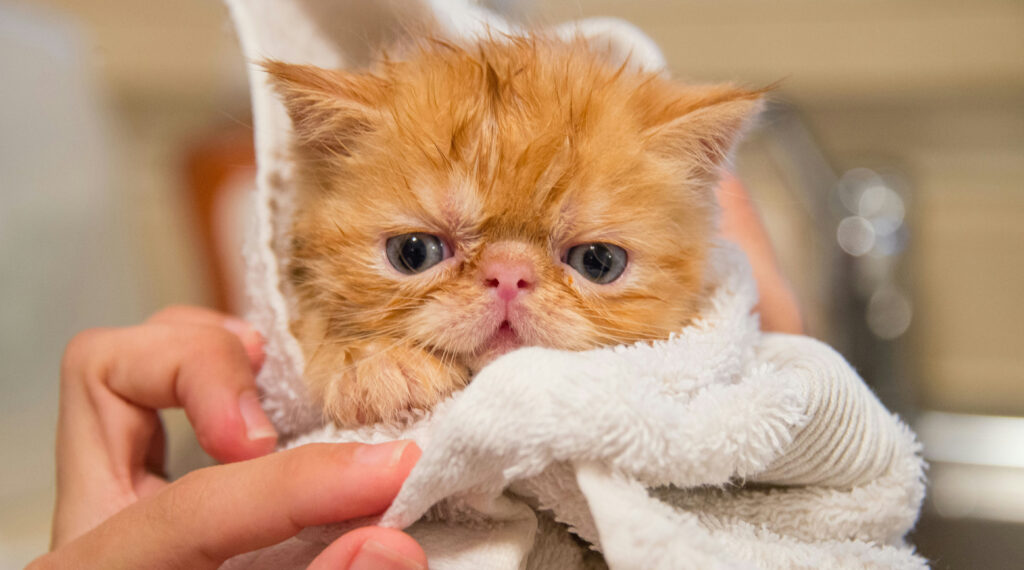Most cats act like water is their sworn enemy — and if you’ve ever tried giving yours a bath, you probably understand why! I’ll never forget my first attempt at bathing my long-haired cat: let’s just say it looked like a crime scene afterward, and I’m not talking about the bathroom.
While most cats do a fantastic job keeping themselves clean, sometimes a real bath is unavoidable: think muddy adventures, flea problems, or those mysterious messes that make you wonder what they got into.
The good news? Bath time doesn’t have to be a total disaster. With a bit of planning (and a lot of patience), you and your cat can survive bath day with minimal drama. Here’s what I’ve learned through trial and error:
When (and when not) to bathe your cat
Generally, healthy indoor cats rarely need full baths. Their grooming habits keep them pretty spotless! You might consider a bath if:
- Your cat gets into something sticky, smelly, or potentially toxic
- They have a skin condition or fleas (as recommended by your vet)
- They’re older or overweight and can’t groom properly
Important tip: Overbathing can dry out your cat’s skin and coat — so only do it when truly needed.
Prep work: your secret weapon
A successful cat bath starts long before the water runs. Trust me on this one — preparation is everything.
Before bath day:
- Brush thoroughly: Remove tangles and loose fur. Mats get worse when wet!
- Trim nails carefully: Just the tips — for your protection and theirs.
- Pick your spot: Many people find a sink works better than a big tub. Less overwhelming for the cat.
- Gather supplies:
- Cat-specific shampoo (never use human or dog shampoo)
- Multiple towels (one to place under your cat, extras for drying)
- A cup or gentle sprayer
- Treats for bribery — I mean, positive reinforcement
Lay everything within arm’s reach — once your cat’s wet, you definitely won’t want to go hunting for supplies while holding a soggy, unhappy feline!
The (not-so) big moment: bath time
- Add a non-slip mat or towel in the sink/tub so your cat feels secure. Slipping makes everything worse.
- Fill with just a few inches of lukewarm water — test it with your wrist like you would for a baby.
- Gently wet your cat, starting from the neck down. Avoid the head — most cats really hate water on their face, and honestly, who can blame them?
- Lather up with a small amount of cat shampoo. Go slowly and speak in a calm, soothing voice. This is not the time for efficiency over gentleness.
- Rinse thoroughly. Any leftover shampoo can irritate their skin, and an itchy cat is an unhappy cat.
- For the face, use a damp washcloth instead of pouring water. Much less traumatic for everyone involved.
Drying & aftercare
Wrap your cat in a dry towel and gently pat (don’t rub!) to remove moisture. Some cats tolerate a hair dryer on the lowest heat and speed — but many absolutely don’t. If you try this, keep it moving and never point it directly at their face.
Finish off with plenty of treats and praise. Your cat might give you the cold shoulder for a while, but you’ll both recover!
Tips to make bath time less stressful
- Keep sessions short — fast and gentle beats thorough and traumatic every time
- Use a helper if possible: one person holds, one bathes
- Consider alternatives: waterless shampoo or professional groomers for cats who absolutely won’t cooperate
- Stay calm yourself — cats are incredibly good at sensing our stress and tension
What to expect afterward
Let’s be honest: your cat will probably spend the next few hours grooming themselves and giving you judgmental looks. This is completely normal. They’re not plotting your demise (probably), they’re just processing the experience in their own feline way.
Bathing your cat will probably never be their favorite activity — or yours, for that matter. But with preparation, patience, and maybe a sense of humor about the whole situation, you can get them clean without turning your bathroom into a disaster zone. And hey, at least you’ll have some entertaining stories to share with fellow cat parents!
(⚠️ Disclaimer: This guide offers general tips only. If your cat has skin issues, chronic illness, or special needs, check with your vet before bathing.)

